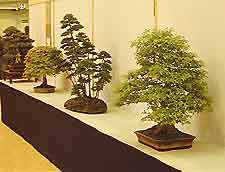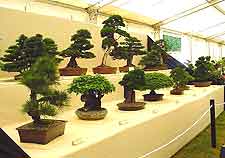Bonsai Trees
Displaying Bonsai in Public Exhibitions

Exhibiting bonsai trees in public is often the culmination of many years of training and can be a very proud and satisfying experience for the exhibitor. The venue may be in a flower tent at a local horticultural show, a society display staged in a school hall or at a national exhibition in a large venue. It provides the chance to encourage and educate other enthusiasts, whilst also promoting the hobby. Take the time to study other trees at eye level.
What makes them a successful or poor bonsai? What techniques have been used in their training? Where possible, bonsai should be displayed against a plain background, untextured and neutral in colour. To display bonsai at their absolute best requires meticulous preparation prior to the exhibition.
Important points to remember when displaying bonsai:

- Ensure that the soil surface is free from weeds, dead leaves and other debris. Remove the top centimetre of soil and replace with finely sieved Japanese Akadama clay. The soil should be level with the sides of the pot, mounding up slightly to the buttress
- Underplant with a selection of moss, forming a green 'island' around the base of the tree, but not completely covering the soil. This will create a natural landscaped feeling. Use a variety of different size moss to emulate the many colours and contours of plants that grow underneath trees in the wild, trimming off moss seeds with scissors. Accentuate the surface roots by carefully positioning moss either side of some roots and if possible, cover any ugly roots that spoil the overall appearance
- Use a toothbrush to clean off unsightly algae and surface lichens from trunks and branches. Show the buttress to its best advantage by ensuring that it is fully exposed, together with all surface roots. Trim any visible root hairs that may be sticking up out of the soil
- Remove any unnecessary wires, ties and clamps. Remaining wire should be very neat and discreet. Avoid silver wire unless the tree is to be exhibited in an educational 'trees in training' section. Make sure that the tree is completely stable in its pot and that any tying wires are not visible
- The bonsai must always be in excellent health and free from pests and diseases. Feed several weeks before so that the foliage is a healthy green colour and showing no signs of nutrient deficiency
- Clean the pot with water and when dry, carefully wipe unglazed or dull pots with a small amount of oil to improve the colour. A very fine oil such as wood-scratch remover is ideal, as this is unlikely to attract dust. This should be done at least two days before the exhibition so that it has time to soak in
- Define foliage masses by trimming downward growth. For pines, cedars and larches, remove any downward pointing needles by carefully pulling them out. Groom branches by pruning overgrown shoots to shape and thin growth - ideally most foliage pads should be made up from smaller masses. Carry out any leaf pruning at least six weeks before the exhibition, so that the tree has fully leafed out and the foliage is not sparse. However, do not carry out this procedure any later than early summer. Remove any damaged, oversized or dead leaves from the bonsai and protect delicate trees from strong winds and scorching sunshine, so that leaves remain in good condition
- Where possible, display the tree on a suitable wooden bonsai stand. Powerful trees are well suited to strong, solid tables and more informal trees favour slightly delicate stands. Conifers are best complemented with dark wood stands and deciduous trees look better when a lighter shade of wood is used. Other alternative stands which can be effective include a 'slice' of polished tree trunk, a piece of stained wood, natural slate, woven bamboo/raffia matting or even painted polystyrene blocks. Well matched with the bonsai, a stand helps to complete the picture
- Do not use ornaments, such as figures or animals. A good bonsai should not need these to provide the illusion of scale and they can be distracting, taking focus away from the actual tree
- If possible, select an appropriate accent planting or rock that reflects the character and mood of the tree. It is important that these are not overpowering and do not detract from the bonsai being exhibited. A tall literati pine tree would be enhanced by a small pot of tall reeds, whereas a much thicker trunked, heavily barked pine would look good next to a rough piece of stone displayed in a shallow suiban filled with fine sand or water
- Over exhibiting can be very damaging, as the environment, differing temperatures and build up of dust may prove stressful for the bonsai. After the exhibition, water well from above to wash the leaves thoroughly
 Exhibiting bonsai trees in public is often the culmination of many years of training and can be a very proud and satisfying experience for the exhibitor. The venue may be in a flower tent at a local horticultural show, a society display staged in a school hall or at a national exhibition in a large venue. It provides the chance to encourage and educate other enthusiasts, whilst also promoting the hobby. Take the time to study other trees at eye level.
Exhibiting bonsai trees in public is often the culmination of many years of training and can be a very proud and satisfying experience for the exhibitor. The venue may be in a flower tent at a local horticultural show, a society display staged in a school hall or at a national exhibition in a large venue. It provides the chance to encourage and educate other enthusiasts, whilst also promoting the hobby. Take the time to study other trees at eye level.